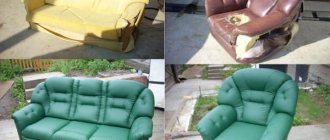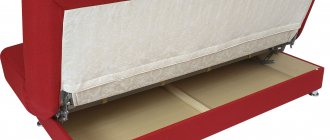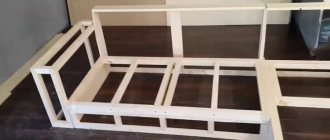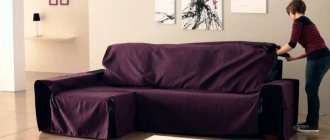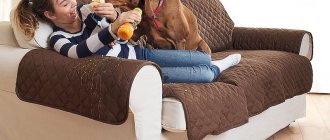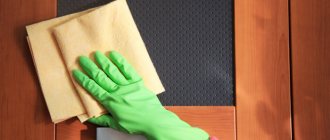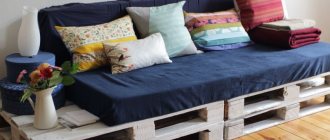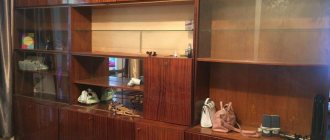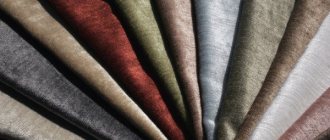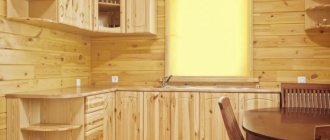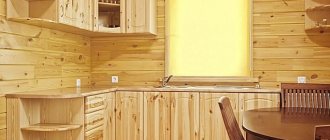It's no secret that over time, the upholstery of upholstered furniture loses its original appearance, especially if there are pets in the house; old furniture often does not fit into the new interior after renovation. In this case, you should not replace existing furniture with new interior items.
A simpler solution would be to replace the upholstery fabric and soft lining of upholstered furniture. In most cases this is not at all difficult to do. This short review provides detailed instructions on how to reupholster a sofa with your own hands.
Damage and types of repair
Damage to a sofa or other upholstered furniture can vary in severity. Depending on the existing injuries, a different range of work is required. Here's what can happen to your furniture:
- Only the fabric became unusable (cats tore on the armrests, for example), i.e. There are no dips in the soft part or protruding parts. Then everything is more or less simple and you can get by by replacing the upholstery fabric.
The simplest case is if you need to replace the fabric - There are some dents in some places . This damage is caused by wear and tear on the components that make up the upholstered part of the sofa. Depending on the degree of damage and the design of the sofa itself, it may be necessary to replace padding polyester and other underlying layers. In more severe cases, repair of spring blocks, if any, or foam rubber/silicone if the sofa is spring is required. If the upholstery looks quite good, it can be washed and used again.
- Dim in the bottom of the seat. Sometimes, due to high loads, the springs pierce the bottom of the frame. This happens most often if it is made of fiberboard. In this case, you will have to disassemble everything, remove the spring dock, replace the fiberboard (preferably with plywood).
This sufferer needs more than just replacement upholstery... - Damage to the frame . One of the most unpleasant things is cracks in the frame bars. The sofa will have to be completely disassembled, the broken bars replaced, and then everything restored. This is a complete reupholstery of the sofa. Essentially, you're building a new one.
So reupholstering a sofa can involve different jobs. From simply replacing the upholstery to a complete renovation, including part of the frame. The most troublesome part is with the spring blocks. This is long and painstaking work. If the “historical accuracy” of your furniture is not important to you, it is easier to replace a failed spring block with foam rubber or (better, but more expensive) furniture silicone. If everything is done correctly, the sofa will become even more comfortable: incorrectly tightened springs cause a lot of inconvenience.
Cutting upholstery fabric
Fabrics for new upholstery are cut using old patterns. To do this, you need to straighten the patterns, attach them to a piece of fabric and secure with pins. Next, we trace the pattern along the contour and cut it out, notching along the edges. When sewing, be sure to pay attention to the direction of the longitudinal thread.
If the old upholstery fabric is severely deformed or stretched, then some parts of the sofa will need to be measured with a flexible ruler. To strengthen the seams, choose a more reliable type of binding, zigzag the free edges of the fabric.
Types of "soft part"
Let's talk in general terms about what the seat and back of the sofa can be made of. There are options:
- Without springs: High-density foam rubber (polyurethane foam, also called PU foam) (also called furniture rubber).
- Foamed latex. In terms of quality and convenience, it is better than foam rubber, but also much more expensive.
- with classic springs connected into one block;
When restoring a sofa, you need to examine the layers.
These are the most common types of sofa seats. In more expensive models, the spring block can be supplemented with a layer of polyurethane foam or latex, which makes the seat more elastic and comfortable at the same time. When reupholstering, they then look at the condition of both parts, replace or leave them - depending on desire and capabilities.
The structure of sofa seats can be multi-layered
But that's not all the layers. In addition to springs, polyurethane foam/latex, padding polyester or thermal felt (or regular felt) are also laid. This is if the sofa is more or less modern and not too expensive. Older exhibits may contain matting or burlap, batting (or something very similar), horsehair, dried seaweed and other now almost exotic materials for sofa stuffing. When repairing a sofa, they will need to be replaced with the same ones (if you want to look) or similar in thickness and properties. So, to understand how a sofa should be reupholstered, first understand what’s inside it.
In what cases can you not do without the help of professionals?
- If the useful life of the product exceeds 5 years. Surely, in addition to worn upholstery, damage to frame elements occurs. When pulling furniture, you need to fix all the defects and you may not have the necessary tools or spare parts on hand.
- If you are going to reupholster furniture with leather or leatherette. This is a difficult material to work with, and it is not always possible to do it correctly at home.
An interesting individual sofa design requires the help of a professional
Leather upholstered chair padding
Classic sofa in a new velvet upholstery
We disassemble the sofa and assess the scale of work
Reupholstering a sofa begins with disassembling it. During the process, you will be able to assess the extent of the damage and decide what exactly you need to do. For this part of the job you will need:
- a large screwdriver to unscrew visible bolts (if any);
- a small flat-head screwdriver, pliers or staple remover - to remove the staples that secure the upholstery.
The main thing is to remove the old upholstery.
Then everything will become clear. Actually, everything. First, remove the individual pillows, if any, and remove the side panels. It’s difficult to suggest here - there are many designs. Look carefully, you are sure to find something. If you have retractable parts, you can try starting with them.
Separating the upholstery
The next step is to separate the fabric from the frame. It is attached with staples to the wooden bars of the frame. We pry the staples with a flat screwdriver and pull them out. Some may fit very tightly; it is easier to pull them out by grabbing them by the raised back with pliers or pliers.
We disassemble the sofa: remove the staples
We remove the fabric carefully, trying not to damage it too much. We will then use it as a sample for new sofa upholstery. There are several layers underneath the upholstery fabric. Maybe felt, padding polyester, some kind of fabric. If the sofa repair was started only to replace the upholstery, look at the condition of these materials. If there are signs of wear, it is better to replace. After all, it will be a shame if in a few months the sofa needs to be reupholstered again, but this time because the layers of the lining have been removed.
If the sofa is old, there may be a picture like this
Once the fabric is removed, it's time to evaluate which parts you'll need to replace. Everything is clear with the upholstery and lining underneath. It is advisable to keep the pie in the same composition. If old materials were used that are not currently on sale or are too expensive, replace them with modern analogues. The main thing for folding sofas is to reach the same height of the seat and back that were before, since folding mechanisms are designed for certain parameters of the “pillows”. In order not to be mistaken with the thickness of materials, find unworn (or least worn) areas and measure the thickness.
Assessing the damage
This stage is needed if the sofa seat is uneven, there are humps and depressions, protruding springs (and from below too). In seats that consist only of foam rubber, everything is simple: they are usually replaced. They can be made from high-density foam rubber by folding several layers; you can order ready-made foam rubber at a store that sells furniture spare parts. It is wise to order a latex mattress according to exact dimensions (measure after removing the fabric and all layers).
If the sofa has springs, remove all the covering layers to get to them. If there are no burst springs, the frame and its connections are strong, without play or cracks, the backing for the springs is in good condition, you can stop there. We change the covering layers, sew a new cover, stretch it and fasten it. This completes the reupholstery of the sofa.
One of the common defects in spring blocks is a broken spring.
There are also such sofas - with spring snakes that are attached to the frame and give elasticity to the foam mattress standing on top
This type of sofa breakdown is also common: the fiberboard on the frame is broken
Inspect the spring block for broken springs
If there is any damage listed above, the spring unit will have to be separated. It is attached to the frame frame using U-shaped brackets or nails. Now you have completely disassembled your sofa into its components. Next is the replacement and repair of damaged parts, and then reassembly.
Required Tools
To complete the work, you will need standard tools, since reupholstery does not require specific products. For the process you will need:
- regular furniture stapler;
- screwdriver;
- sharp knife;
- pliers, hammer, scissors, pliers, needle and some other small tools.
For more reliable fastening of materials, it is recommended to additionally purchase high-quality PVA glue.
Classic sofa pie with a spring block and possible problems
To understand how to repair a sofa at home, you need to know what layers of materials are needed and in what order. For example, in a sofa seat with a spring block the sequence will be like this (from bottom to top):
- Frame made of plywood or wooden blocks. A plywood frame is more reliable, but it takes longer and is more difficult to make. Therefore, pine bars are usually used. They are connected according to the tenon-groove principle, gluing the joint with wood glue. If desired, the connections can be strengthened with dowels or corners (aluminum).
What layers should there be in a sofa seat? - Base for spring block . There may be options: lamellas (straps of elastic material), fiberboard, plywood. The most budget option is fiberboard, the most expensive is lamellas. The lamellas are attached to special stops (lamella holders). When using plastic stops, there is a risk of them breaking. At the same time, low-quality lamellas can bend (in normal condition they are curved slightly upward) or break - to reduce cost they are often placed at large intervals. All this leads to the fact that the sofa seat is pressed through. Instead of wooden slats, there may also be snake springs. They also have sufficient elasticity, but cost less. The problems with them are the same.
- The spring block itself . The block can be with independent or dependent springs. The first one is cheaper, the second one supports the body well. Such mattresses are also called orthopedic.
- Felt or thick fabric (teak or other similar dense fabric will do). This layer is needed so that the springs do not push through the foam rubber located above.
This is what the slats look like from below
If the fabric is thin, it will tear, then the foam will begin to crumble. But this is not the saddest thing - the lamellas were bent in the opposite direction. In normal condition they should be curved upwards
Using a grosgrain ribbon allows you to redistribute the load - Polyurethane foam (PPU, foam rubber - all names of the same material). Special dense foam rubber is used. If you choose, in addition to density, look at such an indicator as the durability coefficient - the higher the number, the better (and more expensive). This indicator reflects how long the foam will take to restore its original shape after removing the load. Its thickness is taken according to the original, factory cake. You can make it thicker without restrictions only on upholstered furniture that does not fold out (banquette, sofa, armchair).
- Sintepon . This is necessary so that the fabric does not “erase” the polyurethane foam. It is usually glued to a layer of foam rubber so that it does not bunch up during use. The glue is taken in a can.
- Upholstery fabric . The best are tapestry, chenille. They don't fray and it's easy to sew with them. Flock and jacquard are good fabrics, but some of them “creep” at the seams. Therefore, when you sew, the seams need to be strengthened. By the way, it is better to sew upholstery for a sofa using special Tytan brand threads. Regular ones, even thick ones, will quickly tear.
These are all the layers and their features. You can add something (for example, a double layer of padding polyester), but removing it is highly undesirable.
Material selection
First of all, you need to decide what fabric will be used for the upholstery. The table describes the advantages and disadvantages of each material.
| Material | Advantages | Flaws |
| Genuine Leather |
|
|
| Cotton |
| wrinkles and wears out quickly |
| Jacquard |
| quite expensive |
| Flock |
|
|
| Tapestry | adds sophistication to furniture |
|
| Velours |
| wipes quickly |
| Chenille |
|
|
| Arpatek |
|
|
It is recommended to avoid synthetic and rough fabrics. You should not buy material with a strong odor; this is a sign of the use of toxic and low-quality dyes.
The design of a sofa on snake springs and options for its restoration
Snake springs in expensive models are used as an additional means to increase elasticity. In budget models, a foam block can be placed on this base. They are attached to a wooden or metal frame across the seat - each spring separately. The installation step depends on the planned load. If your sofa begins to sag, or the springs have lost their elasticity or are broken, the solution is to replace them.
The spring, due to its elasticity, supports the materials on top
This is what it looks like disassembled
An expensive imported sofa is also made on a snake
To increase elasticity and extend service life, when reupholstering a sofa, the number of “snakes” can be increased. Another option is transverse reinforcement with rigid corsage ribbons (which are used for straps on bags and backpacks).
For durability and greater elasticity, use grosgrain ribbon
The tape is nailed on one side to the frame. Professional furniture makers then tighten it using a special tool, but it can be replaced with a regular block wrapped around the middle with coarse-grain sandpaper. You wrap a couple of turns of tape around this beam, pull with both hands (make sure that the frame does not bend), secure the tape with staples or nails, release and cut off the excess. The same method is also suitable for increasing the service life of a mattress with slats.
How much material to buy
After the material has been selected, it is necessary to calculate how much of it to purchase. The easiest way to calculate the amount of fabric is to add the length and width of the sofa. Double the resulting amount. For example, a sofa measuring 2.5 x 1.8. In this case, you need to purchase about 7 meters.
To make the calculation as correctly as possible, it is recommended to adhere to the following instructions:
- Take accurate measurements of all elements of the sofa. In this case, you need to measure the longest and widest parts of the back, seat, armrests and pillows, adding a few centimeters for seam allowances.
- Draw a diagram of the sofa, be sure to ensure that the parts are positioned correctly.
- Add all vertical values and divide by 100. The resulting value is approximately equal to the required length of fabric in meters.
- To determine the width of a piece of fabric, you need to take the widest part from the horizontal piece.
- For a more comfortable cut, it is recommended to add 1 meter for every 5 meters to the resulting length and width.
The approximate material consumption depends on the type of sofa:
- 2-seater - about 10-14 sq. m;
- 3-seater - up to 15 sq.m. m;
- kitchen corner - up to 6 sq. m;
- corner sofa - about 22 sq. m.
Material consumption increases if a complex pattern is applied to the fabric, which must be selected when connecting elements of the sofa, in the absence of a project and pattern.
An example of sofa repair with step-by-step photos
The old sofa became completely uncomfortable, began to sag in places and creak. There is no way to buy a new one, it was decided to reupholster and change the upholstery. As usual, reupholstering a sofa begins with disassembly. The legs were removed first. The railings were fastened with two large bolts; they were unscrewed and removed without any problems. Further disassembly is also not difficult - we unscrew the bolts that appear one by one.
Dismantling the sofa
When all the components were separated, the old upholstery was removed. The staples were easy to remove - the frame was made of pine timber. The spring block itself turned out to be without defects, but there was a crack in the frame, one of the frame beams sagged, the fiberboard sagged, although there were no cracks.
Frame repair
Since the frame bears the main load, it is better to replace damaged elements. We carefully measure them, draw them schematically, and put down the dimensions in millimeters. With the drawing we go to the carpentry shop. Please pay special attention: the wood must be dry, preferably kiln dried. If you know how to work with wood yourself, you can do it yourself.
Defects close up
It was decided to connect the frame, as it was, with a tenon/groove, coated with wood glue. But to prevent it from coming loose, the connection was reinforced with metal dowels.
Reassembling the frames
First, the connections are glued and clamped in a vice. A small diameter hole is drilled under the dowel and the dowel is hammered in. The frame stands in a vice until the glue dries.
We will use 4 mm thick plywood as the base for the spring block. The sheets are standard, a little more than 1.5 meters, and the length of the sofa is almost two. It turns out two pieces. It is better to make the joint of the pieces on a jumper, it is more reliable. We cut out rectangles of the required size, coat the frame with wood glue, lay plywood, and nail it with small nails. The length of the nails is so that they do not stick out outside the frame. We additionally support the joint with a plank (50*20 mm).
Let's start re-upholstering the sofa
The updated sofa will serve in the country house, so we try to keep the budget to a minimum; we use an old blanket instead of a backing for the springs. We stretch it well and fasten it with staples using a manual construction stapler.
The base for the springs is an old fleece blanket
If possible, it is advisable to put thermal felt here. It is more reliable and not so expensive. It is cut to size, straightened and nailed around the perimeter. You can use staples or nails with large heads.
Repairing and fixing the spring block
To fasten the spring block, you can use powerful U-shaped brackets, and it is better if their legs are sharpened. But the stapler does not work with these, so we cut staples from steel wire with a diameter of 1.5 mm and hammer them in with a hammer.
Updating the sofa at home: attaching a spring block
In addition to being attached to the frame, the springs are also secured with nylon straps. Twine was taken, folded in two layers, secured with the same wire staples. We tighten the constriction so that it does not press down on the springs, but the tension should be sufficient so that the block “does not move.”
Some dense material should be placed on top of the springs, usually felt. In this case, old flooring was used. Something like felt. It is quite dense and durable. Fold in two layers, cut to size. This layer must be attached to the spring block. The coating is dense, you can’t pierce it with a needle, even a gypsy one. A large diameter awl would be suitable, but there isn't one. We pierce the coating with a nail, which we push through with the handle of a screwdriver. We thread a thick thread into the holes made. The stitch pitch is about 3.5 cm. To speed up the process, we use several nails at once.
Upholstery of a sofa from scrap materials (budget upholstery of a sofa)
Next “according to plan” there should be foam rubber, on top of which a padding polyester is placed. In this project, it was replaced with two layers of densely elastic material, which had been stored in the attic for a long time. Instead of padding polyester, another old blanket was used. To prevent the blanket from moving around, it was grabbed around the perimeter with threads (in conventional technology, synthetic winterizer is glued to polyurethane foam or latex using glue from a can).
Case and cover
Upholstering this sofa turned out to be easy: the shape is simple, without decoration. The old cover was ripped open and a pattern was made from new, not very expensive upholstery fabric. In the place that falls on the corner of the sofa cushion/seat, a thick tape was sewn from the inside to prevent the fabric from fraying. The fabric is inexpensive, so the edges had to be rolled up to prevent fraying. They are often left unprocessed.
We put the finished part in the case
The finished cover was laid out on the floor, and the restored part of the sofa was placed in it. At this stage it is important that the fabric is stretched evenly and does not wrinkle. We started nailing the cover from the middle, moving towards the edges. Staples with thick backs were used to avoid damaging the fabric.
The sofa is almost finished
The back of the sofa was restored in the same way, the armrests were covered, then all the parts were screwed to the folding mechanism. The thickness of the pillows matched, so there were no problems.
The reupholstery of the sofa is finished. Result verified
